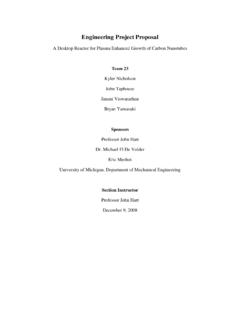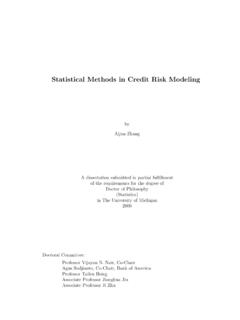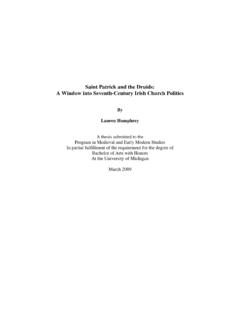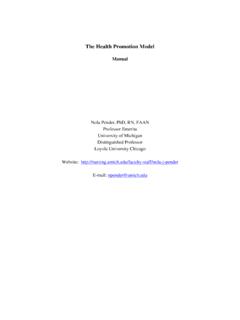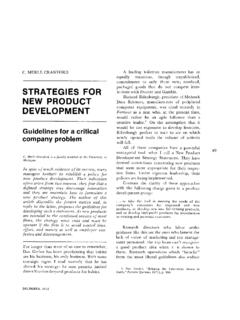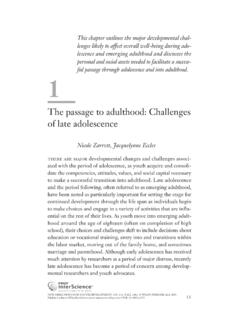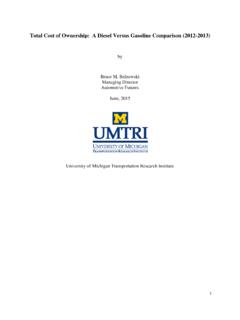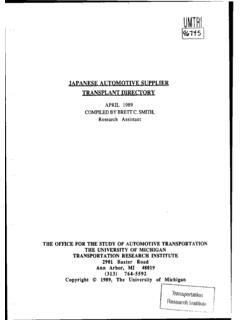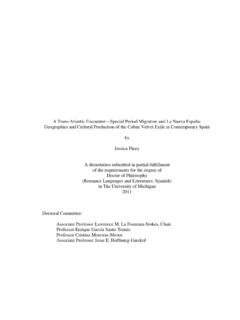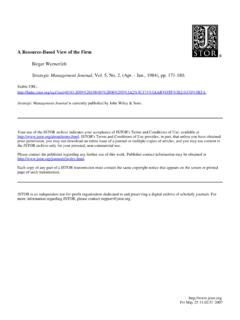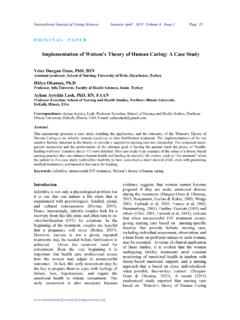Transcription of Nickel-Based Superalloys for Advanced Turbine Engines ...
1 journal OFPROPULSION ANDPOWERVol. 22, No. 2, March April 2006 Nickel-Based Superalloys for Advanced Turbine Engines :Chemistry, Microstructure, and PropertiesTresa M. PollockUniversity of Michigan, Ann Arbor, Michigan 48109andSammy TinUniversity of Cambridge, Cambridge, England CB2 3QZ, United KingdomThe chemical, physical, and mechanical characteristics of Nickel-Based Superalloys are reviewed with emphasison the use of this class of materials within Turbine Engines . The role of major and minor alloying additionsin multicomponent commercial cast and wrought Superalloys is discussed. Microstructural stability and phasesobserved during processing and in subsequent elevated-temperature service are summarized.
2 Processing paths andrecent advances in processing are addressed. Mechanical properties and deformation mechanisms are reviewed,including tensile properties, creep, fatigue, and cyclic crack IntroductionNICKEL- based Superalloys are an unusual class of metal-lic materials with an exceptional combination of high-temperature strength, toughness, and resistance to degradation incorrosive or oxidizing environments. These materials are widelyused in aircraft and power-generation turbines, rocket Engines , andother challenging environments, including nuclear power and chem-ical processing plants. Intensive alloy and process development ac-tivities during the past few decades have resulted in alloys thatcan tolerate average temperatures of 1050 C with occasional ex-cursions (or local hot spots near airfoil tips) to temperatures as highas 1200 C,1which is approximately 90% of the melting point of thematerial.
3 The underlying aspects of microstructure and compositionthat result in these exceptional properties are briefly reviewed classes of Superalloys that are utilized in gas- Turbine enginesand the corresponding processes for their production are outlinedalong with characteristic mechanical and physical Superalloys in Gas- Turbine EnginesNickel- based Superalloys typically constitute 40 50% of the to-tal weight of an aircraft engine and are used most extensively in thecombustor and Turbine sections of the engine where elevated tem-peratures are maintained during turbineblades and vanes are typically fabricated by complex investmentcasting procedures that are essential for introduction of elaboratecooling schemes and for control of grain structure.
4 Such compo-nents may contain equiaxed grains or columnar grains, or may beTresa M. Pollock is the and Van Vlack Professor of Materials Science and Engineering at the University of Michigan, Ann Arbor, received a from Purdue University in 1984 and a from MIT in 1989. Dr. Pollock was employed at General Electric Aircraft Enginesfrom 1989 1991, where she conducted research and development on high temperature alloys for aircraft Turbine Engines . She was a professor in theDepartment of Materials Science and Engineering at Carnegie Mellon University from 1991 1999. Her research interests are in the area of processingand properties of high temperature structural materials, including nickel-base alloys, intermetallics, coatings and composites.
5 Professor Pollock is thePresident of The Minerals, Metals and Materials Society (TMS) and Associate Editor ofMetallurgical and Materials Transactions. She is a Fellow ofASM International and has received the ASM International Research Silver Medal Award. Pollock was elected to the National Academy of Engineeringin Tin is Professor of Mechanical, Materials and Aerospace Engineering at the Illinois Institute of Technology. Prior to joining the faculty atIIT, he served as the Deputy Director of the Rolls-Royce University Technology Partnership at the University of Cambridge, where he led an activegroup of graduate students and post-doctoral researchers working on a range of projects relating to processing and deformation of high-temperaturestructural materials.
6 Professor Tin received his in Materials Science and Engineering from the University of Michigan in 2001. He also receivedan from Carnegie Mellon University and a from California Polytechnique State University, San Luis 16 June 2005; revision received 15 June 2005; accepted for publication 31 August 2005. Copyrightc 2005 by the American Institute of Aeronauticsand Astronautics, Inc. All rights reserved. Copies of this paper may be made for personal or internal use, on condition that the copier pay the $ per-copyfee to the Copyright Clearance Center, Inc., 222 Rosewood Drive, Danvers, MA 01923; include the code 0748-4658/06 $ in correspondence with as single crystals, completely eliminating all high-angle grainboundaries.
7 Because grain boundaries are sites for damage accu-mulation at high temperatures, the blades in the early stages of theturbine are typically single crystals, whereas the blades in the later(cooler) stages of the Turbine are fabricated from equiaxed components such as engine cases are also fabricated by in-vestment casting processes. Turbine disks are fabricated via wroughtprocessing approaches that either use cast ingots or consolidatedsuperalloy powder performs. Exceptional combinations of strength,toughness, and crack-growth resistance can be achieved in thesematerials by close control of microstructure through the multiplestages of wrought processing. Table 1 lists the nominal composi-tion of several common cast and wrought commercial superalloysutilized in gas- Turbine Constitution of SuperalloysAs is apparent from Table 1, although face-centered cubic (FCC)nickel is the major superalloy constituent, many alloys contain up to40 wt % of a combination of five to ten other elements.
8 The elementstypically alloyed with nickel to form a superalloy are highlighted inFig. nickel aluminum system is the binary basis for superalloycompositions. As the level of aluminum added to -nickel increases,a second precipitate phase forms. This phase has a nominal com-position of Ni3Al, is designated the phase, and has an orderedintermetallic L12crystal structure. Formation of the phase occursin the solid state as the supersaturated solid solution of -nickel361362 POLLOCK AND TINT able 1 Compositions of commercial Ni- based Superalloys (wt. %, bal. Ni)AlloyCrCoMoWTaReNbAlTiHfCBYZrOtherCon ventionally Cast Rene Directionally Solidified First-Generation Single-Crystal AlloysPWA Rene Second-Generation Single-Crystal AlloysPWA Rene Third-Generation Single-Crystal AlloysRene Wrought SuperalloysIN Nimonic Udimet Powder-Processed SuperalloysRene Rene 88 1 Alloying elements present in Ni- based Superalloys (adaptedfrom Ref.)
9 2).is cooled below its equilibrium solvus temperature. Hence, the pre-cipitation and growth kinetics of the phase are highly sensitiveto the rate at which the alloy is cooled through the solvus tempera-ture. A unimodal distribution of fine precipitates (300 500 nm)is typically associated with cooling rates in excess of 40 K/min,whereas slower cooling rates tend to promote the formation of mul-tiple populations of precipitates consisting of a combination oflarge (>500 nm) and small (<50 nm) precipitates. The presence of ahigh-volume fraction of the phase is key to strengthening, as isdiscussed in more detail in Sec. V. These two phases remain themajor constituents of the superalloy microstructure, even with theaddition of six to ten additional elements.
10 Figure 2 shows a typicaltwo-phase microstructure for a single-crystal Turbine -blade al-loy. In general, refractory alloying elements with large differencesin electronic structure and atomic radii compared to Ni, such as Mo,W, Nb, and Re, are added for solid-solution strengthening of the phase. Additions of Ti, Ta, and Nb contribute to the formation andstrengthening of the Ni3(Al, Ti, Ta, Nb) ,3 Additions ofiron form the basis of an important group of Ni-Fe Superalloys , withthe most common alloy being IN 718 (Table 1); although this classof Superalloys is not discussed in any detail here, there is extensiveFig. 2 Microstructure of an Ni- based superalloy single crystal reveal-ing a high volume fraction of precipitates, which have a cuboidalmorphology (courtesy of L.)
